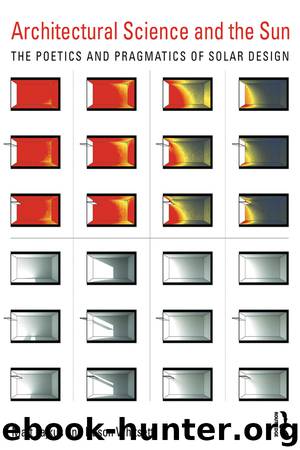Architectural Science and the Sun by Dason Whitsett Matt Fajkus & Dason Whitsett

Author:Dason Whitsett,Matt Fajkus & Dason Whitsett
Language: eng
Format: epub
Publisher: Taylor & Francis (CAM)
6
Received Shadows
The duality of sunlight and shadows, as referenced in the first chapter of this book, is an ancient binary opposition. Tree canopies modulate sunlight, scattering it about the ground beneath. Although there is an inherent geometric rigor about these projections, due to the irregularity of the tree canopy form, it appears to the human eye to be random, making it more compelling. This is further enhanced by the fluttering movement. The same occurs with the movement of clouds overhead, which provides a dynamic setting and an ephemeral sense of natural light.1 Shadows have a role in folklore; it was once considered a terrible curse to lose one’s shadow, and anyone with a headless shadow was predicted to die within a year.2 Although an eclipse of the sun, where the moon passes between the sun and Earth, is a rare occurrence, it is often referred to and highly anticipated. This is partially related to the fact that it is an anomaly within the typical daily solar pattern, and even a partial eclipse creates a highly unique shadow.
In one of the most well-known writings in ancient western civilization, The Republic, Plato described a cave in which the only things to see were shadows, and dismissed this knowledge gathered by the inhabitants of the cave as inferior. The scene, represented in an engraving entitled “The Miracle in the Cave” by Pieter Saenredam in 1604, is set in a subterranean passage beneath the ground (Figure 6.1). In a dimly lit room, the occupants are supposedly part of an experiment. They are unaware of the state of the outside world, as they have been kept in the cave since they were young. Their only focal point is a shadow performance, upon which they fixate. They are unaware of their unusual circumstances, as it is all they know. They are witnessing projections of shadows from statues, which they cannot see, and this becomes their understanding of reality. They have no way of knowing that this two-dimensional performance is not reality, and that they are witnessing a twice-removed representation of reality. Likewise, even though we have more information from which to deduct “reality,” we are still also part of an illusion. Plato maintains that no one has a comprehensive understanding of what truly exists, but shadows are one way we begin to make sense of three dimensions and the world around us.
It could also be argued that Plato attempts to diminish the value of the shadow as only having a limited ability to represent the object from which it is projected. The fact is that shadows do help us more thoroughly understand our surroundings and to establish constructs at various scales. Shadows are both a tool and deeply meaningful entities that help describe formal characteristics of any object and also remind us of the passage of time.
A clear architectural design strategy at the scale of volumetric massing typically includes careful consideration between a building and its light and shade. Greek temples are composed of rhythmic patterns
Download
This site does not store any files on its server. We only index and link to content provided by other sites. Please contact the content providers to delete copyright contents if any and email us, we'll remove relevant links or contents immediately.
| American National Standards Institute (ANSI) Publications | Architecture |
| History | Measurements |
| Patents & Inventions | Research |
Whiskies Galore by Ian Buxton(41879)
Introduction to Aircraft Design (Cambridge Aerospace Series) by John P. Fielding(33064)
Small Unmanned Fixed-wing Aircraft Design by Andrew J. Keane Andras Sobester James P. Scanlan & András Sóbester & James P. Scanlan(32743)
Craft Beer for the Homebrewer by Michael Agnew(18140)
Turbulence by E. J. Noyes(7936)
The Complete Stick Figure Physics Tutorials by Allen Sarah(7307)
Kaplan MCAT General Chemistry Review by Kaplan(6867)
The Thirst by Nesbo Jo(6826)
Bad Blood by John Carreyrou(6552)
Modelling of Convective Heat and Mass Transfer in Rotating Flows by Igor V. Shevchuk(6391)
Learning SQL by Alan Beaulieu(6209)
Weapons of Math Destruction by Cathy O'Neil(6143)
Man-made Catastrophes and Risk Information Concealment by Dmitry Chernov & Didier Sornette(5921)
Digital Minimalism by Cal Newport;(5664)
Life 3.0: Being Human in the Age of Artificial Intelligence by Tegmark Max(5474)
iGen by Jean M. Twenge(5366)
Secrets of Antigravity Propulsion: Tesla, UFOs, and Classified Aerospace Technology by Ph.D. Paul A. Laviolette(5309)
Design of Trajectory Optimization Approach for Space Maneuver Vehicle Skip Entry Problems by Runqi Chai & Al Savvaris & Antonios Tsourdos & Senchun Chai(5011)
Pale Blue Dot by Carl Sagan(4912)
